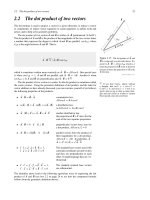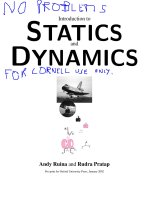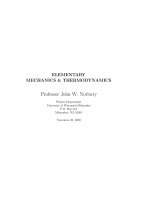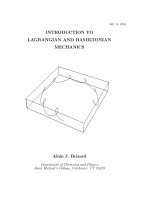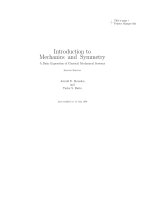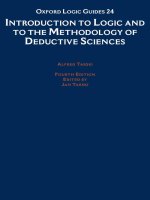- Trang chủ >>
- Khoa Học Tự Nhiên >>
- Vật lý
Introduction to mechanics and symmetry j marsden, t ratiu
Bạn đang xem bản rút gọn của tài liệu. Xem và tải ngay bản đầy đủ của tài liệu tại đây (2.9 MB, 549 trang )
This is page i
Printer: Opaque this
Introduction to
Mechanics and Symmetry
A Basic Exposition of Classical Mechanical Systems
Second Edition
Jerrold E. Marsden
and
Tudor S. Ratiu
Last modified on 15 July 1998
v
To Barbara and Lilian for their love and support
15 July 1998—18h02
vi
15 July 1998—18h02
This is page ix
Printer: Opaque this
Preface
Symmetry and mechanics have been close partners since the time of the
founding masters: Newton, Euler, Lagrange, Laplace, Poisson, Jacobi, Ha-
milton, Kelvin, Routh, Riemann, Noether, Poincar´e, Einstein, Schr¨odinger,
Cartan, Dirac, and to this day, symmetry has continued to play a strong
role, especially with the modern work of Kolmogorov, Arnold, Moser, Kir-
illov, Kostant, Smale, Souriau, Guillemin, Sternberg, and many others. This
book is about these developments, with an emphasis on concrete applica-
tions that we hope will make it accessible to a wide variety of readers,
especially senior undergraduate and graduate students in science and en-
gineering.
The geometric point of view in mechanics combined with solid analy-
sis has been a phenomenal success in linking various diverse areas, both
within and across standard disciplinary lines. It has provided both insight
into fundamental issues in mechanics (such as variational and Hamiltonian
structures in continuum mechanics, fluid mechanics, and plasma physics)
and provided useful tools in specific models such as new stability and bifur-
cation criteria using the energy-Casimir and energy-momentum methods,
new numerical codes based on geometrically exact update procedures and
variational integrators, and new reorientation techniques in control theory
and robotics.
Symmetry was already widely used in mechanics by the founders of the
subject, and has been developed considerably in recent times in such di-
verse phenomena as reduction, stability, bifurcation and solution symmetry
breaking relative to a given system symmetry group, methods of finding
explicit solutions for integrable systems, and a deeper understanding of spe-
x Preface
cial systems, such as the Kowalewski top. We hope this book will provide
a reasonable avenue to, and foundation for, these exciting developments.
Because of the extensive and complex set of possible directions in which
one can develop the theory, we have provided a fairly lengthy introduction.
It is intended to be read lightly at the beginning and then consulted from
time to time as the text itself is read.
This volume contains much of the basic theory of mechanics and should
prove to be a useful foundation for further, as well as more specialized
topics. Due to space limitations we warn the reader that many important
topics in mechanics are not treated in this volume. We are preparing a
second volume on general reduction theory and its applications. With luck,
a little support, and yet more hard work, it will be available in the near
future.
Solutions Manual. A solution manual is available for insturctors that
contains complete solutions to many of the exercises and other supplemen-
tary comments. This may be obtained from the publisher.
Internet Supplements. To keep the size of the book within reason,
we are making some material available (free) on the internet. These are
a collection of sections whose omission does not interfere with the main
flow of the text. See Updates
and information about the book can also be found there.
What is New in the Second Edition? In this second edition, the
main structural changes are the creation of the Solutions manual (along
with many more Exercises in the text) and the internet supplements. The
internet supplements contain, for example, the material on the Maslov in-
dex that was not needed for the main flow of the book. As for the substance
of the text, much of the book was rewritten throughout to improve the flow
of material and to correct inaccuracies. Some examples: the material on the
Hamilton-Jacobi theory was completely rewritten, a new section on Routh
reduction (§8.9) was added, Chapter 9 on Lie groups was substantially im-
proved and expanded and the presentation of examples of coadjoint orbits
(Chapter 14) was improved by stressing matrix methods throughout.
Acknowledgments. We thank Alan Weinstein, Rudolf Schmid, and Rich
Spencer for helping with an early set of notes that helped us on our way.
Our many colleagues, students, and readers, especially Henry Abarbanel,
Vladimir Arnold, Larry Bates, Michael Berry, Tony Bloch, Hans Duister-
maat, Marty Golubitsky, Mark Gotay, George Haller, Aaron Hershman,
Darryl Holm, Phil Holmes, Sameer Jalnapurkar, Edgar Knobloch, P.S.
Krishnaprasad, Naomi Leonard, Debra Lewis, Robert Littlejohn, Richard
Montgomery, Phil Morrison, Richard Murray, Peter Olver, Oliver O’Reilly,
Juan-Pablo Ortega, George Patrick, Octavian Popp, Matthias Reinsch,
Shankar Sastry, Juan Simo, Hans Troger, and Steve Wiggins have our deep-
est gratitude for their encouragement and suggestions. We also collectively
15 July 1998—18h02
xi
thank all our students and colleagues who have used these notes and have
provided valuable advice. We are also indebted to Carol Cook, Anne Kao,
Nawoyuki Gregory Kubota, Sue Knapp, Barbara Marsden, Marnie McEl-
hiney, June Meyermann, Teresa Wild, and Ester Zack for their dedicated
and patient work on the typesetting and artwork for this book. We want
to single out with special thanks, Nawoyuki Gregory Kubota and Wendy
McKay for their special effort with the typesetting and the figures (includ-
ing the cover illustration). We also thank the staff at Springer-Verlag, espe-
cially Achi Dosanjh, Laura Carlson, Ken Dreyhaupt and R¨udiger Gebauer
for their skillful editorial work and production of the book.
Jerry Marsden
Pasadena, California
Tudor Ratiu
Santa Cruz, California
Summer, 1998
15 July 1998—18h02
xii
About the Authors
Jerrold E. Marsden is Professor of Control and Dynamical Systems at Caltech.
He got his B.Sc. at Toronto in 1965 and his Ph.D. from Princeton University in
1968, both in Applied Mathematics. He has done extensive research in mechan-
ics, with applications to rigid body systems, fluid mechanics, elasticity theory,
plasma physics as well as to general field theory. His primary current interests
are in the area of dynamical systems and control theory, especially how it relates
to mechanical systems with symmetry. He is one of the founders in the early
1970’s of reduction theory for mechanical systems with symmetry, which remains
an active and much studied area of research today. He was the recipient of the
prestigious Norbert Wiener prize of the American Mathematical Society and the
Society for Industrial and Applied Mathematics in 1990, and was elected a fellow
of the AAAS in 1997. He has been a Carnegie Fellow at Heriot–Watt Univer-
sity (1977), a Killam Fellow at the University of Calgary (1979), recipient of the
Jeffrey–Williams prize of the Canadian Mathematical Society in 1981, a Miller
Professor at the University of California, Berkeley (1981–1982), a recipient of the
Humboldt Prize in Germany (1991), and a Fairchild Fellow at Caltech (1992). He
has served in several administrative capacities, such as director of the Research
Group in Nonlinear Systems and Dynamics at Berkeley, 1984–86, the Advisory
Panel for Mathematics at NSF, the Advisory committee of the Mathematical Sci-
ences Institute at Cornell, and as Director of The Fields Institute, 1990–1994. He
has served as an Editor for Springer-Verlag’s Applied Mathematical Sciences Se-
ries since 1982 and serves on the editorial boards of several journals in mechanics,
dynamics, and control.
Tudor S. Ratiu is Professor of Mathematics at UC Santa Cruz and the Swiss
Federal Institute of Technology in Lausanne. He got his B.Sc. in Mathematics and
M.Sc. in Applied Mathematics, both at the University of Timi¸soara, Romania,
and his Ph.D. in Mathematics at Berkeley in 1980. He has previously taught at
the University of Michigan, Ann Arbor, as a T. H. Hildebrandt Research Assis-
tant Professor (1980–1983) and at the University of Arizona, Tucson (1983–1987).
His research interests center on geometric mechanics, symplectic geometry, global
analysis, and infinite dimensional Lie theory, together with their applications to
integrable systems, nonlinear dynamics, continuum mechanics, plasma physics,
and bifurcation theory. He has been a National Science Foundation Postdoctoral
Fellow (1983–86), a Sloan Foundation Fellow (1984–87), a Miller Research Pro-
fessor at Berkeley (1994), and a recipient of of the Humboldt Prize in Germany
(1997). Since his arrival at UC Santa Cruz in 1987, he has been on the executive
committee of the Nonlinear Sciences Organized Research Unit. He is currently
managing editor of the AMS Surveys and Monographs series and on the edito-
rial board of the Annals of Global Analysis and the Annals of the University of
Timi¸soara. He was also a member of various research institutes such as MSRI in
Berkeley, the Center for Nonlinear Studies at Los Alamos, the Max Planck Insti-
tute in Bonn, MSI at Cornell, IHES in Bures–sur–Yvette, The Fields Institute in
Toronto (Waterloo), the Erwin Schro¨odinger Institute for Mathematical Physics
in Vienna, the Isaac Newton Institute in Cambridge, and RIMS in Kyoto.
15 July 1998—18h02
This is page xiii
Printer: Opaque this
Contents
Preface ix
About the Authors xii
I The Book xiv
1 Introduction and Overview 1
1.1 Lagrangian and Hamiltonian Formalisms 1
1.2 The Rigid Body 6
1.3 Lie–Poisson Brackets, Poisson Manifolds, Momentum Maps 9
1.4 TheHeavyTop 16
1.5 Incompressible Fluids 18
1.6 The Maxwell–Vlasov System 22
1.7 Nonlinear Stability 29
1.8 Bifurcation 43
1.9 The Poincar´e–Melnikov Method 46
1.10 Resonances, Geometric Phases, and Control 49
2 Hamiltonian Systems on Linear Symplectic Spaces 61
2.1 Introduction 61
2.2 Symplectic Forms on Vector Spaces 65
2.3 Canonical Transformations or Symplectic Maps 69
2.4 The General Hamilton Equations 73
2.5 When Are Equations Hamiltonian? 76
xiv Contents
2.6 Hamiltonian Flows 80
2.7 Poisson Brackets 82
2.8 A Particle in a Rotating Hoop 85
2.9 The Poincar´e–Melnikov Method and Chaos 92
3 An Introduction to Infinite-Dimensional Systems 103
3.1 Lagrange’s and Hamilton’s Equations for Field Theory . . . 103
3.2 Examples: Hamilton’s Equations 105
3.3 Examples: Poisson Brackets and Conserved Quantities . . . 113
4 Interlude: Manifolds, Vector Fields, and Differential Forms119
4.1 Manifolds 119
4.2 Differential Forms 126
4.3 The Lie Derivative 133
4.4 Stokes’ Theorem 137
5 Hamiltonian Systems on Symplectic Manifolds 143
5.1 Symplectic Manifolds 143
5.2 Symplectic Transformations 146
5.3 Complex Structures and K¨ahler Manifolds 148
5.4 Hamiltonian Systems 153
5.5 Poisson Brackets on Symplectic Manifolds 156
6 Cotangent Bundles 161
6.1 The Linear Case 161
6.2 The Nonlinear Case 163
6.3 Cotangent Lifts 166
6.4 Lifts of Actions 169
6.5 Generating Functions 170
6.6 Fiber Translations and Magnetic Terms 172
6.7 A Particle in a Magnetic Field 174
7 Lagrangian Mechanics 177
7.1 Hamilton’s Principle of Critical Action 177
7.2 The Legendre Transform 179
7.3 Euler–Lagrange Equations 181
7.4 Hyperregular Lagrangians and Hamiltonians 184
7.5 Geodesics 191
7.6 The Kaluza–Klein Approach to Charged Particles 196
7.7 Motion in a Potential Field 198
7.8 The Lagrange–d’Alembert Principle 201
7.9 The Hamilton–Jacobi Equation 206
8 Variational Principles, Constraints, and Rotating Systems215
8.1 A Return to Variational Principles 215
15 July 1998—18h02
Contents xv
8.2 The Geometry of Variational Principles 222
8.3 Constrained Systems 230
8.4 Constrained Motion in a Potential Field 234
8.5 Dirac Constraints 238
8.6 Centrifugal and Coriolis Forces 244
8.7 The Geometric Phase for a Particle in a Hoop 249
8.8 Moving Systems 253
8.9 Routh Reduction 256
9 An Introduction to Lie Groups 261
9.1 Basic Definitions and Properties 263
9.2 Some Classical Lie Groups 279
9.3 Actions of Lie Groups 308
10 Poisson Manifolds 329
10.1 The Definition of Poisson Manifolds 329
10.2 Hamiltonian Vector Fields and Casimir Functions 335
10.3 Properties of Hamiltonian Flows 340
10.4 The Poisson Tensor 342
10.5 Quotients of Poisson Manifolds 355
10.6 The Schouten Bracket 358
10.7 Generalities on Lie–Poisson Structures 365
11 Momentum Maps 371
11.1 Canonical Actions and Their Infinitesimal Generators . . . 371
11.2 Momentum Maps 373
11.3 An Algebraic Definition of the Momentum Map 376
11.4 Conservation of Momentum Maps 378
11.5 Equivariance of Momentum Maps 384
12 Computation and Properties of Momentum Maps 391
12.1 Momentum Maps on Cotangent Bundles 391
12.2 Examples of Momentum Maps 396
12.3 Equivariance and Infinitesimal Equivariance 404
12.4 Equivariant Momentum Maps Are Poisson 411
12.5 Poisson Automorphisms 420
12.6 Momentum Maps and Casimir Functions 421
13 Lie–Poisson and Euler–Poincar´e Reduction 425
13.1 The Lie–Poisson Reduction Theorem 425
13.2 Proof of the Lie–Poisson Reduction Theorem for GL(n) 428
13.3 Proof of the Lie–Poisson Reduction Theorem for Diff
vol
(M) 429
13.4 Lie–Poisson Reduction using Momentum Functions 431
13.5 Reduction and Reconstruction of Dynamics 433
13.6 The Linearized Lie–Poisson Equations 442
15 July 1998—18h02
xvi Contents
13.7 The Euler–Poincar´e Equations 445
13.8 The Lagrange–Poincar´e Equations 456
14 Coadjoint Orbits 459
14.1 Examples of Coadjoint Orbits 460
14.2 Tangent Vectors to Coadjoint Orbits 467
14.3 The Symplectic Structure on Coadjoint Orbits 469
14.4 The Orbit Bracket via Restriction of the Lie–Poisson Bracket 475
14.5 The Special Linear Group on the Plane 483
14.6 The Euclidean Group of the Plane 485
14.7 The Euclidean Group of Three-Space 490
15 The Free Rigid Body 499
15.1 Material, Spatial, and Body Coordinates 499
15.2 The Lagrangian of the Free Rigid Body 501
15.3 The Lagrangian and Hamiltonian in Body Representation . 503
15.4 Kinematics on Lie Groups 507
15.5 Poinsot’s Theorem 508
15.6 Euler Angles 511
15.7 The Hamiltonian of the Free Rigid Body in the Material
Description via Euler Angles 513
15.8 The Analytical Solution of the Free Rigid Body Problem . . 516
15.9 Rigid Body Stability 521
15.10Heavy Top Stability 525
15.11The Rigid Body and the Pendulum 529
15 July 1998—18h02
Part I
The Book
xvii
This is page xviii
Printer: Opaque this
0
15 July 1998—18h02
This is page 1
Printer: Opaque this
1
Introduction and Overview
1.1 Lagrangian and Hamiltonian Formalisms
Mechanics deals with the dynamics of particles, rigid bodies, continuous
media (fluid, plasma, and solid mechanics), and field theories such as elec-
tromagnetism, gravity, etc. This theory plays a crucial role in quantum
mechanics, control theory, and other areas of physics, engineering and even
chemistry and biology. Clearly mechanics is a large subject that plays a
fundamental role in science. Mechanics also played a key part in the devel-
opment of mathematics. Starting with the creation of calculus stimulated
by Newton’s mechanics, it continues today with exciting developments in
group representations, geometry, and topology; these mathematical devel-
opments in turn are being applied to interesting problems in physics and
engineering.
Symmetry plays an important role in mechanics, from fundamental for-
mulations of basic principles to concrete applications, such as stability cri-
teria for rotating structures. The theme of this book is to emphasize the
role of symmetry in various aspects of mechanics.
This introduction treats a collection of topics fairly rapidly. The student
should not expect to understand everything perfectly at this stage. We will
return to many of the topics in subsequent chapters.
Lagrangian and Hamiltonian Mechanics. Mechanics has two main
points of view, Lagrangian mechanics and Hamiltonian mechanics.
In one sense, Lagrangian mechanics is more fundamental since it is based
on variational principles and it is what generalizes most directly to the
2 1. Introduction and Overview
general relativistic context. In another sense, Hamiltonian mechanics is
more fundamental, since it is based directly on the energy concept and it is
what is more closely tied to quantum mechanics. Fortunately, in many cases
these branches are equivalent as we shall see in detail in Chapter 7. Needless
to say, the merger of quantum mechanics and general relativity remains
one of the main outstanding problems of mechanics. In fact, the methods
of mechanics and symmetry are important ingredients in the developments
of string theory that has attempted this merger.
Lagrangian Mechanics. The Lagrangian formulation of mechanics is
based on the observation that there are variational principles behind the
fundamental laws of force balance as given by Newton’s law F = ma.
One chooses a configuration space Q with coordinates q
i
,i =1, ,n,
that describe the configuration of the system under study. Then one
introduces the Lagrangian L(q
i
, ˙q
i
,t), which is shorthand notation for
L(q
1
, ,q
n
, ˙q
1
, , ˙q
n
,t). Usually, L is the kinetic minus the potential
energy of the system and one takes ˙q
i
= dq
i
/dt to be the system velocity.
The variational principle of Hamilton states
δ
b
a
L(q
i
, ˙q
i
,t) dt =0. (1.1.1)
In this principle, we choose curves q
i
(t) joining two fixed points in Q over
a fixed time interval [a, b], and calculate the integral regarded as a function
of this curve. Hamilton’s principle states that this function has a critical
point at a solution within the space of curves. If we let δq
i
be a variation,
that is, the derivative of a family of curves with respect to a parameter,
then by the chain rule, (1.1.1) is equivalent to
n
i=1
b
a
∂L
∂q
i
δq
i
+
∂L
∂ ˙q
i
δ ˙q
i
dt = 0 (1.1.2)
for all variations δq
i
.
Using equality of mixed partials, one finds that
δ ˙q
i
=
d
dt
δq
i
.
Using this, integrating the second term of (1.1.2) by parts, and employing
the boundary conditions δq
i
=0att = a and b, (1.1.2) becomes
n
i=1
b
a
∂L
∂q
i
−
d
dt
∂L
∂ ˙q
i
δq
i
dt =0. (1.1.3)
Since δq
i
is arbitrary (apart from being zero at the endpoints), (1.1.2) is
equivalent to the Euler–Lagrange equations
d
dt
∂L
∂ ˙q
i
−
∂L
∂q
i
=0,i=1, ,n. (1.1.4)
15 July 1998—18h02
1.1 Lagrangian and Hamiltonian Formalisms 3
As Hamilton himself realized around 1830, one can also gain valuable in-
formation by not imposing the fixed endpoint conditions. We will have a
deeper look at such issues in Chapters 7 and 8.
For a system of N particles moving in Euclidean 3-space, we choose the
configuration space to be Q = R
3N
= R
3
×···×R
3
(N times) and L often
has the form of kinetic minus potential energy:
L(q
i
,
˙
q
i
,t)=
1
2
N
i=1
m
i
˙
q
i
2
− V (q
i
), (1.1.5)
where we write points in Q as q
1
, ,q
N
, where q
i
∈ R
3
. In this case the
Euler–Lagrange equations (1.1.4) reduce to Newton’s second law
d
dt
(m
i
˙
q
i
)=−
∂V
∂q
i
; i =1, ,N (1.1.6)
that is, F = ma for the motion of particles in the potential field V .Aswe
shall see later, in many examples more general Lagrangians are needed.
Generally, in Lagrangian mechanics, one identifies a configuration space
Q (with coordinates q
1
, ,q
n
)) and then forms the velocity phase space
TQ also called the tangent bundle of Q. Coordinates on TQ are denoted
(q
1
, ,q
n
, ˙q
1
, , ˙q
n
),
and the Lagrangian is regarded as a function L : TQ → R.
Already at this stage, interesting links with geometry are possible. If
g
ij
(q) is a given metric tensor or mass matrix (for now, just think of this
as a q-dependent positive-definite symmetric n×n matrix) and we consider
the kinetic energy Lagrangian
L(q
i
, ˙q
i
)=
1
2
n
i,j=1
g
ij
(q)˙q
i
˙q
j
, (1.1.7)
then the Euler–Lagrange equations are equivalent to the equations of geodesic
motion, as can be directly verified (see §7.5 for details). Conservation laws
that are a result of symmetry in a mechanical context can then be applied
to yield interesting geometric facts. For instance, theorems about geodesics
on surfaces of revolution can be readily proved this way.
The Lagrangian formalism can be extended to the infinite dimensional
case. One view (but not the only one) is to replace the q
i
by fields ϕ
1
, ,ϕ
m
which are, for example, functions of spatial points x
i
and time. Then L
is a function of ϕ
1
, ,ϕ
m
, ˙ϕ
1
, , ˙ϕ
m
and the spatial derivatives of the
fields. We shall deal with various examples of this later, but we emphasize
that properly interpreted, the variational principle and the Euler–Lagrange
equations remain intact. One replaces the partial derivatives in the Euler–
Lagrange equations by functional derivatives defined below.
15 July 1998—18h02
4 1. Introduction and Overview
Hamiltonian Mechanics. To pass to the Hamiltonian formalism, in-
troduce the conjugate momenta
p
i
=
∂L
∂ ˙q
i
,i=1, ,n, (1.1.8)
make the change of variables (q
i
, ˙q
i
) → (q
i
,p
i
), and introduce the Hamil-
tonian
H(q
i
,p
i
,t)=
n
j=1
p
j
˙q
j
− L(q
i
, ˙q
i
,t). (1.1.9)
Remembering the change of variables, we make the following computations
using the chain rule:
∂H
∂p
i
=˙q
i
+
n
j=1
p
j
∂ ˙q
j
∂p
i
−
∂L
∂ ˙q
j
∂ ˙q
j
∂p
i
=˙q
i
(1.1.10)
and
∂H
∂q
i
=
n
j=1
p
j
∂ ˙q
j
∂q
i
−
∂L
∂q
i
−
n
j=1
∂L
∂ ˙q
j
∂ ˙q
j
∂q
i
= −
∂L
∂q
i
, (1.1.11)
where (1.1.8) has been used twice. Using (1.1.4) and (1.1.8), we see that
(1.1.11) is equivalent to
∂H
∂q
i
= −
d
dt
p
i
. (1.1.12)
Thus, the Euler–Lagrange equations are equivalent to Hamilton’s equa-
tions
dq
i
dt
=
∂H
∂p
i
,
dp
i
dt
= −
∂H
∂q
i
,
(1.1.13)
where i =1, ,n. The analogous Hamiltonian partial differential equa-
tions for time dependent fields ϕ
1
, ,ϕ
m
and their conjugate momenta
π
1
, , π
m
, are
∂ϕ
a
∂t
=
δH
δπ
a
∂π
a
∂t
= −
δH
δϕ
a
,
(1.1.14)
15 July 1998—18h02
1.1 Lagrangian and Hamiltonian Formalisms 5
where a =1, ,m, and H is a functional of the fields ϕ
a
and π
a
, and the
variational or functional derivatives are defined by the equation
R
n
δH
δϕ
1
δϕ
1
d
n
x = lim
ε→0
1
ε
[H(ϕ
1
+εδϕ
1
,ϕ
2
, ,ϕ
m
,π
1
, ,π
m
)
− H(ϕ
1
,ϕ
2
, ,ϕ
m
,π
1
, ,π
m
)], (1.1.15)
and similarly for δH/δϕ
2
, ,δH/δπ
m
. Equations (1.1.13) and (1.1.14) can
be recast in Poisson bracket form
˙
F = {F,H}, (1.1.16)
where the brackets in the respective cases are given by
{F, G} =
n
i=1
∂F
∂q
i
∂G
∂p
i
−
∂F
∂p
i
∂G
∂q
i
(1.1.17)
and
{F, G} =
m
a=1
R
n
δF
δϕ
a
δG
δπ
a
−
δF
δπ
a
δG
δϕ
a
d
n
x. (1.1.18)
Associated to any configuration space Q (coordinatized by (q
1
, ,q
n
))
is a phase space T
∗
Q called the cotangent bundle of Q, which has coordi-
nates (q
1
, ,q
n
,p
1
, ,p
n
). On this space, the canonical bracket (1.1.17)
is intrinsically defined in the sense that the value of {F, G} is indepen-
dent of the choice of coordinates. Because the Poisson bracket satisfies
{F, G} = −{G, F } and in particular {H, H} = 0 , we see from (1.1.16)
that
˙
H = 0; that is, energy is conserved. This is the most elementary
of many deep and beautiful conservation properties of mechanical sys-
tems.
There is also a variational principle on the Hamiltonian side. For the
Euler–Lagrange equations, we deal with curves in q-space (configuration
space), whereas for Hamilton’s equations we deal with curves in (q,p)-space
(momentum phase space). The principle is
δ
b
a
n
i=1
[p
i
˙q
i
− H(q
j
,p
j
)] dt = 0 (1.1.19)
as is readily verified; one requires p
i
δq
i
= 0 at the endpoints.
This formalism is the basis for the analysis of many important systems
in particle dynamics and field theory, as described in standard texts such
as Whittaker [1927], Goldstein [1980], Arnold [1989], Thirring [1978], and
Abraham and Marsden [1978]. The underlying geometric structures that are
important for this formalism are those of symplectic and Poisson geometry.
15 July 1998—18h02
6 1. Introduction and Overview
How these structures are related to the Euler–Lagrange equations and vari-
ational principles via the Legendre transformation is an essential ingredient
of the story. Furthermore, in the infinite-dimensional case it is fairly well
understood how to deal rigorously with many of the functional analytic
difficulties that arise; see, for example, Chernoff and Marsden [1974] and
Marsden and Hughes [1983].
Exercises
1.1-1. Show by direct calculation that the classical Poisson bracket sat-
isfies the Jacobi identity. That is, if F and K are both functions of the
2n variables (q
1
,q
2
, ,q
n
,p
1
,p
2
, , p
n
) and we define
{F, K} =
n
i=1
∂F
∂q
i
∂K
∂p
i
−
∂K
∂q
i
∂F
∂p
i
,
then the identity {L, {F, K}} + {K, {L, F }}+ {F,{K, L}} = 0 holds.
1.2 The Rigid Body
It was already clear in the last century that certain mechanical systems
resist the canonical formalism outlined in §1.1. For example, to obtain a
Hamiltonian description for fluids, Clebsch [1857, 1859] found it necessary
to introduce certain nonphysical potentials
1
. We will discuss fluids in §1.4
below.
Euler’s Rigid Body Equations. In the absence of external forces, the
Euler equations for the rotational dynamics of a rigid body about its cen-
ter of mass are usually written as follows, as we shall derive in detail in
Chapter 15:
I
1
˙
Ω
1
=(I
2
− I
3
)Ω
2
Ω
3
,
I
2
˙
Ω
2
=(I
3
− I
1
)Ω
3
Ω
1
,
I
3
˙
Ω
3
=(I
1
− I
2
)Ω
1
Ω
2
,
(1.2.1)
where Ω = (Ω
1
, Ω
2
, Ω
3
) is the body angular velocity vector (the angular
velocity of the rigid body as seen from a frame fixed in the body) and
I
1
,I
2
,I
3
are constants depending on the shape and mass distribution of
the body—the principal moments of inertia of the rigid body.
1
For a geometric account of Clebsch potentials and further references, see Marsden
and Weinstein [1983], Marsden, Ratiu, and Weinstein [1984a,b], Cendra and Marsden
[1987], and Cendra, Ibort, and Marsden [1987].
15 July 1998—18h02
1.2 The Rigid Body 7
Are equations (1.2.1) Lagrangian or Hamiltonian in any sense? Since
there are an odd number of equations, they obviously cannot be put in
canonical Hamiltonian form in the sense of equations (1.1.13).
A classical way to see the Lagrangian (or Hamiltonian) structure of the
rigid body equations is to use a description of the orientation of the body
in terms of three Euler angles denoted θ, ϕ, ψ and their velocities
˙
θ, ˙ϕ,
˙
ψ
(or conjugate momenta p
θ
,p
ϕ
,p
ψ
), relative to which the equations are in
Euler–Lagrange (or canonical Hamiltonian) form. However, this procedure
requires using six equations while many questions are easier to study using
the three equations (1.2.1).
Lagrangian Form. To see the sense in which (1.2.1) are Lagrangian,
introduce the Lagrangian
L(Ω)=
1
2
(I
1
Ω
2
1
+ I
2
Ω
2
2
+ I
3
Ω
2
3
) (1.2.2)
which, as we will see in detail in Chapter 15, is the (rotational) kinetic
energy of the rigid body. Regarding IΩ=(I
1
Ω
1
,I
2
Ω
2
,I
3
Ω
3
) as a vector,
write (1.2.1) as
d
dt
∂L
∂Ω
=
∂L
∂Ω
× Ω. (1.2.3)
These equations appear explicitly in Lagrange [1788] (Volume 2, p.212)
and were generalized to arbitrary Lie algebras by Poincar´e [1901b]. We will
discuss these general Euler-Poincar´e equations in Chapter 13. We can
also write a variational principle for (1.2.3) that is analogous to that for the
Euler–Lagrange equations, but is written directly in terms of Ω. Namely,
(1.2.3) is equivalent to
δ
b
a
Ldt=0, (1.2.4)
where variations of Ω are restricted to be of the form
δΩ =
˙
Σ + Ω × Σ, (1.2.5)
where Σ is a curve in R
3
that vanishes at the endpoints. This may be
proved in the same way as we proved that the variational principle (1.1.1)
is equivalent to the Euler–Lagrange equations (1.1.4); see Exercise 1.2-2.
In fact, later on in Chapter 13, we shall see how to derive this variational
principle from the more “primitive” one (1.1.1).
Hamiltonian Form. If, instead of variational principles, we concentrate
on Poisson brackets and drop the requirement that they be in the canon-
ical form (1.1.17), then there is also a simple and beautiful Hamiltonian
15 July 1998—18h02
8 1. Introduction and Overview
structure for the rigid body equations. To state it, introduce the angular
momenta
Π
i
= I
i
Ω
i
=
∂L
∂Ω
i
,i=1, 2, 3, (1.2.6)
so that the Euler equations become
˙
Π
1
=
I
2
− I
3
I
2
I
3
Π
2
Π
3
,
˙
Π
2
=
I
3
− I
1
I
3
I
1
Π
3
Π
1
,
˙
Π
3
=
I
1
− I
2
I
1
I
2
Π
1
Π
2
,
(1.2.7)
that is,
˙
Π = Π × Ω. (1.2.8)
Introduce the following rigid body Poisson bracket on functions of the
Π’s:
{F, G}(Π)=−Π ·(∇F ×∇G) (1.2.9)
and the Hamiltonian
H =
1
2
Π
2
1
I
1
+
Π
2
2
I
2
+
Π
2
3
I
3
. (1.2.10)
One checks (Exercise 1.2-3) that Euler’s equations (1.2.7) are equivalent
to
2
˙
F = {F,H}. (1.2.11)
For any equation of the form (1.2.11), conservation of total angular mo-
mentum holds regardless of the Hamiltonian; indeed, with
C(Π)=
1
2
(Π
2
1
+Π
2
2
+Π
2
3
),
we have ∇C(Π)=Π, and so
d
dt
1
2
(Π
2
1
+Π
2
2
+Π
2
3
)={C, H}(Π)
= −Π · (∇C ×∇H)
= −Π · (Π ×∇H)=0.
2
This simple result is implicit in many works, such as Arnold [1966, 1969], and is
given explicitly in this form for the rigid body in Sudarshan and Mukunda [1974]. (Some
preliminary versions were given by Pauli [1953], Martin [1959], and Nambu [1973].) On
the other hand, the variational form (1.2.4) appears to be due to Poincar´e [1901b] and
Hamel [1904], at least implicitly. It is given explicitly for fluids in Newcomb [1962] and
Bretherton [1970] and in the general case in Marsden and Scheurle [1993a,b].
15 July 1998—18h02
1.2 The Rigid Body 9
The same calculation shows that {C, F} = 0 for any F . Functions such
as these that Poisson commute with every function are called Casimir
functions; they play an important role in the study of stability,aswe
shall see later
3
.
Exercises
1.2-1. Show by direct calculation that the rigid body Poisson bracket
satisfies the Jacobi identity. That is, if F and K are both functions of
(Π
1
, Π
2
, Π
3
) and we define
{F, K}(Π)=−Π ·(∇F ×∇K),
then the identity {L, {F, K}} + {K, {L, F }}+ {F,{K, L}} = 0 holds.
1.2-2. Verify directly that the Euler equations for a rigid body are equiv-
alent to
δ
Ldt=0
for variations of the form δΩ =
˙
Σ + Ω × Σ, where Σ vanishes at the
endpoints.
1.2-3. Verify directly that the Euler equations for a rigid body are equiv-
alent to the equations
d
dt
F = {F,H},
where {, } is the rigid body Poisson bracket and H is the rigid body Hamil-
tonian.
1.2-4.
(a) Show that the rotation group SO(3) can be identified with the Poin-
car´e sphere: that is, the unit circle bundle of the two sphere S
2
,
defined to be the set of unit tangent vectors to the two-sphere in R
3
.
(b) Using the known fact from basic topolgy that any (continuous) vec-
tor field on S
2
must vanish somewhere, show that SO(3) cannot be
written as S
2
× S
1
.
3
H. B. G. Casimir was a student of P. Ehrenfest and wrote a brilliant thesis on
the quantum mechanics of the rigid body, a problem that has not been adequately
addressed in the detail that would be desirable, even today. Ehrenfest in turn wrote his
thesis under Boltzmann around 1900 on variational principles in fluid dynamics and was
one of the first to study fluids from this point of view in material, rather than Clebsch
representation. Curiously, Ehrenfest used the Gauss–Hertz principle of least curvature
rather than the more elementary Hamilton prinicple. This is a seed for many important
ideas in this book.
15 July 1998—18h02
10 1. Introduction and Overview
1.3 Lie–Poisson Brackets,
Poisson Manifolds, Momentum Maps
The rigid body variational principle and the rigid body Poisson bracket
are special cases of general constructions associated to any Lie algebra g,
that is, a vector space together with a bilinear, antisymmetric bracket [ξ,η]
satisfying Jacobi’s identity:
[[ξ,η],ζ]+[[ζ,ξ],η]+[[η, ζ],ξ] = 0 (1.3.1)
for all ξ,η,ζ ∈ g. For example, the Lie algebra associated to the rotation
group is g = R
3
with bracket [ξ, η]=ξ × η, the ordinary vector cross
product.
The Euler-Poincar´e Equations. The construction of a variational prin-
ciple on g, replaces
δΩ =
˙
Σ + Ω × Σ by δξ =˙η +[η, ξ].
The resulting general equations on g, which we will study in detail in Chap-
ter 13, are called the Euler-Poincar´e equations. These equations are
valid for either finite or infinite dimensional Lie algebras. To state them in
the finite dimensional case, we use the following notation. Choosing a basis
e
1
, ,e
r
of g (so dim g = r), the structure constants C
d
ab
are defined
by the equation
[e
a
,e
b
]=
r
d=1
C
d
ab
e
d
, (1.3.2)
where a, b run from 1 to r.Ifξ is an element of the Lie algebra, its compo-
nents relative to this basis are denoted ξ
a
.Ife
1
, ,e
r
is the corresponding
dual basis, then the components of the differential of the Lagrangian L are
the partial derivatives ∂L/∂ξ
a
. Then the Euler-Poincar´e equations are
d
dt
∂L
∂ξ
d
=
r
a,b=1
C
b
ad
∂L
∂ξ
b
ξ
a
. (1.3.3)
The coordinate-free version reads
d
dt
∂L
∂ξ
=ad
∗
ξ
∂L
∂ξ
,
where ad
ξ
: g → g is the linear map η → [ξ, η] and ad
∗
ξ
: g
∗
→ g
∗
is its
dual. For example, for L : R
3
→ R, the Euler-Poincar´e equations become
d
dt
∂L
∂Ω
=
∂L
∂Ω
× Ω,
15 July 1998—18h02
1.3 Lie–Poisson Brackets, Poisson Manifolds, Momentum Maps 11
which generalize the Euler equations for rigid body motion. As we men-
tioned earlier, these equations were written down for a fairly general class
of L by Lagrange [1788, Volume 2, Equation A on p. 212], while it was
Poincar´e [1901b] who generalized them to any Lie algebra.
The generalization of the rigid body variational principle states that the
Euler–Poincar´e equations are equivalent to
δ
Ldt= 0 (1.3.4)
for all variations of the form δξ =˙η +[ξ, η] for some curve η in g that
vanishes at the end points.
The Lie–Poisson Equations. We can also generalize the rigid body
Poisson bracket as follows: Let F, G be defined on the dual space g
∗
. De-
noting elements of g
∗
by µ, let the functional derivative of F at µ be
the unique element δF/δµ of g defined by
lim
ε→0
1
ε
[F (µ + εδµ) −F (µ)] =
δµ,
δF
δµ
, (1.3.5)
for all δµ ∈ g
∗
, where , denotes the pairing between g
∗
and g. This
definition (1.3.5) is consistent with the definition of δF/δϕ given in (1.1.15)
when g and g
∗
are chosen to be appropriate spaces of fields. Define the (±)
Lie–Poisson brackets by
{F, G}
±
(µ)=±
µ,
δF
δµ
,
δG
δµ
. (1.3.6)
Using the coordinate notation introduced above, the (±) Lie–Poisson brack-
ets become
{F, G}
±
(µ)=±
r
a,b,d=1
C
d
ab
µ
d
∂F
∂µ
a
∂G
∂µ
b
, (1.3.7)
where µ = µ
a
e
a
.
Poisson Manifolds. The Lie–Poisson bracket and the canonical brackets
from the last section have four simple but crucial properties:
PB1 {F, G} is real bilinear in F and G.
PB2 {F, G} = −{G, F }, antisymmetry.
PB3 {F, G},H} + {{H, F},G}+ {{G, H},F} =0, Jacobi identity.
PB4 {FG,H} = F {G, H} + {F, H}G, Leibniz identity.
A manifold (that is, an n-dimensional “smooth surface”) P together
with a bracket operation on F(P), the space of smooth functions on P ,
15 July 1998—18h02
